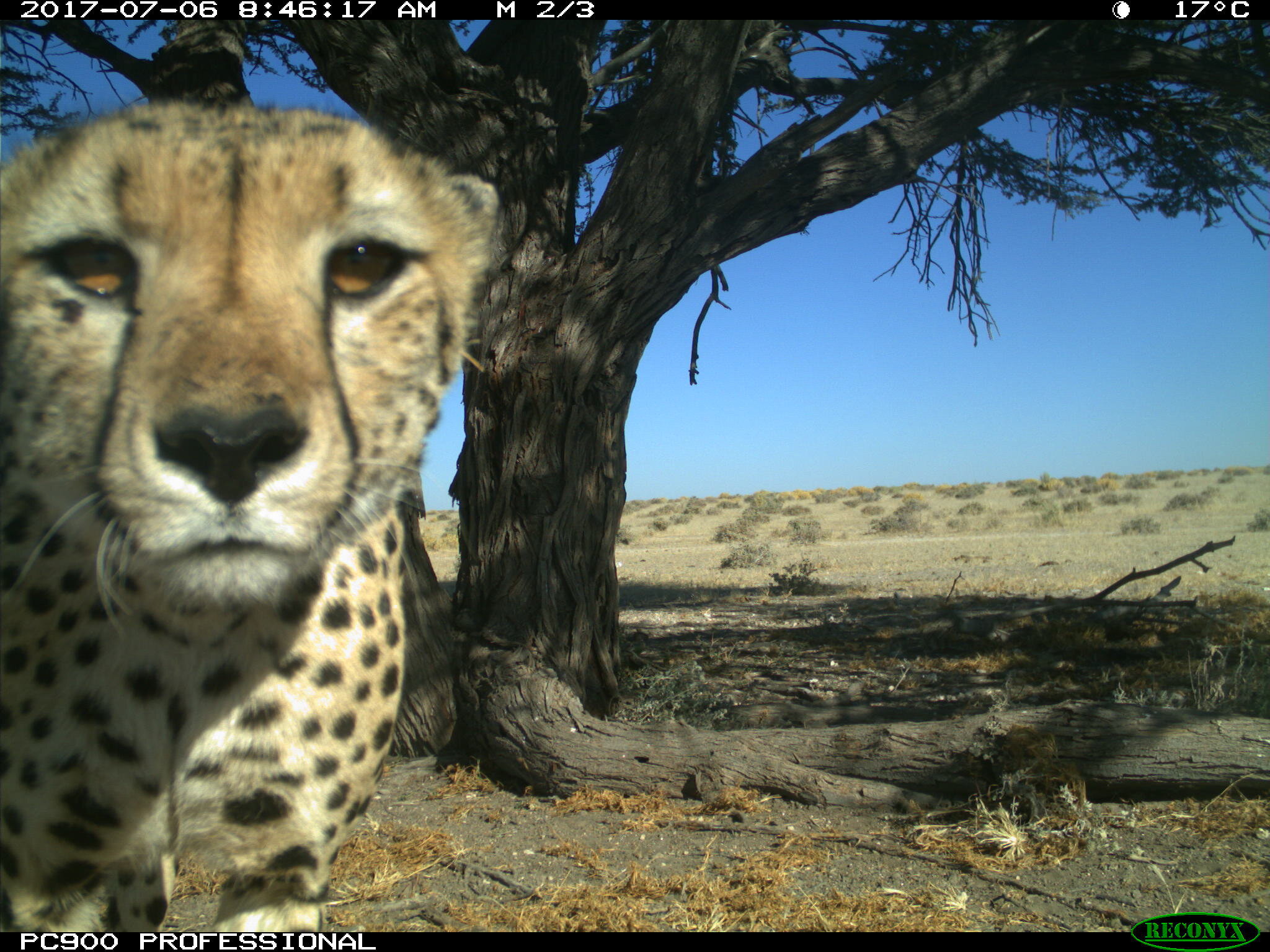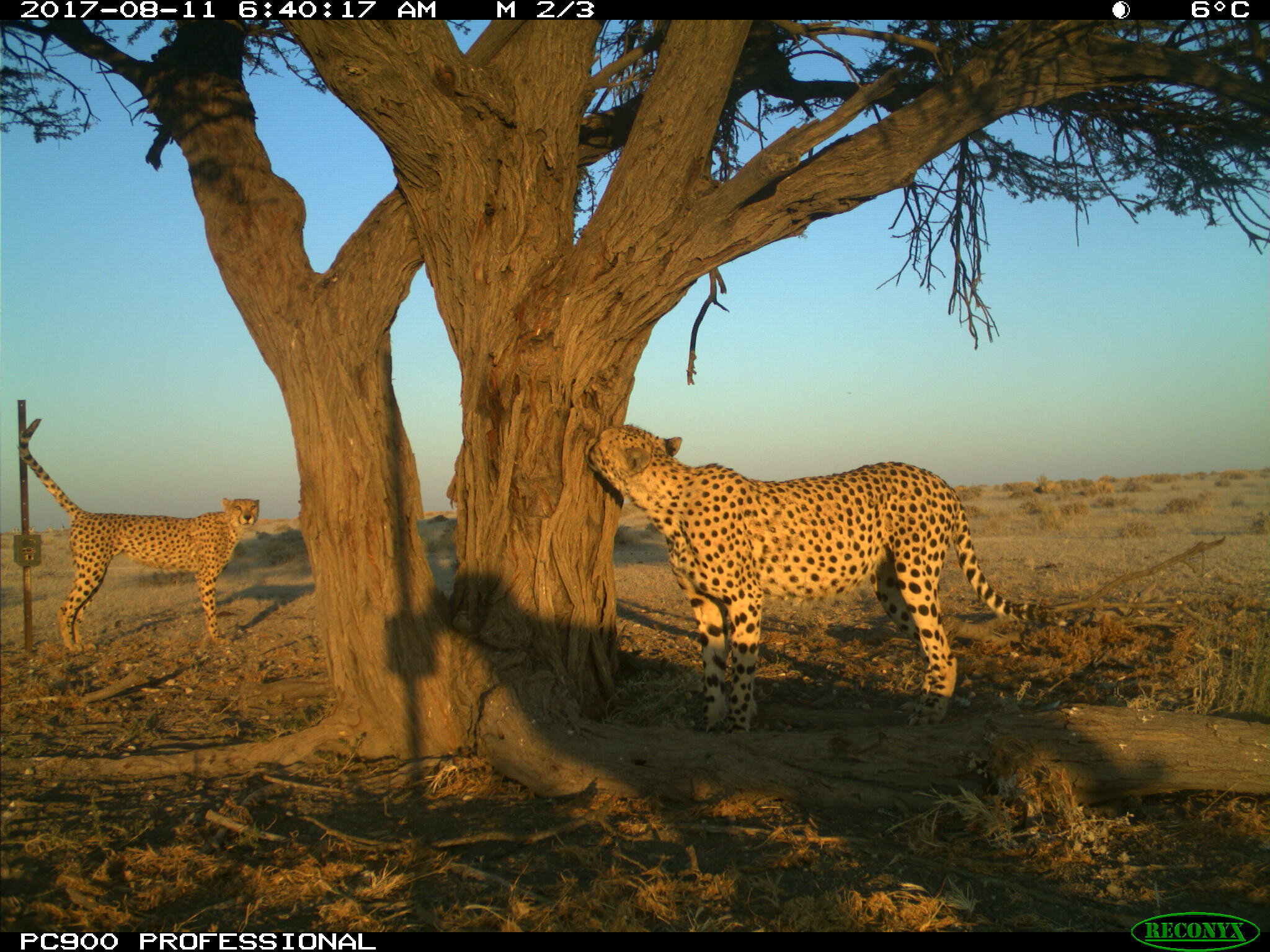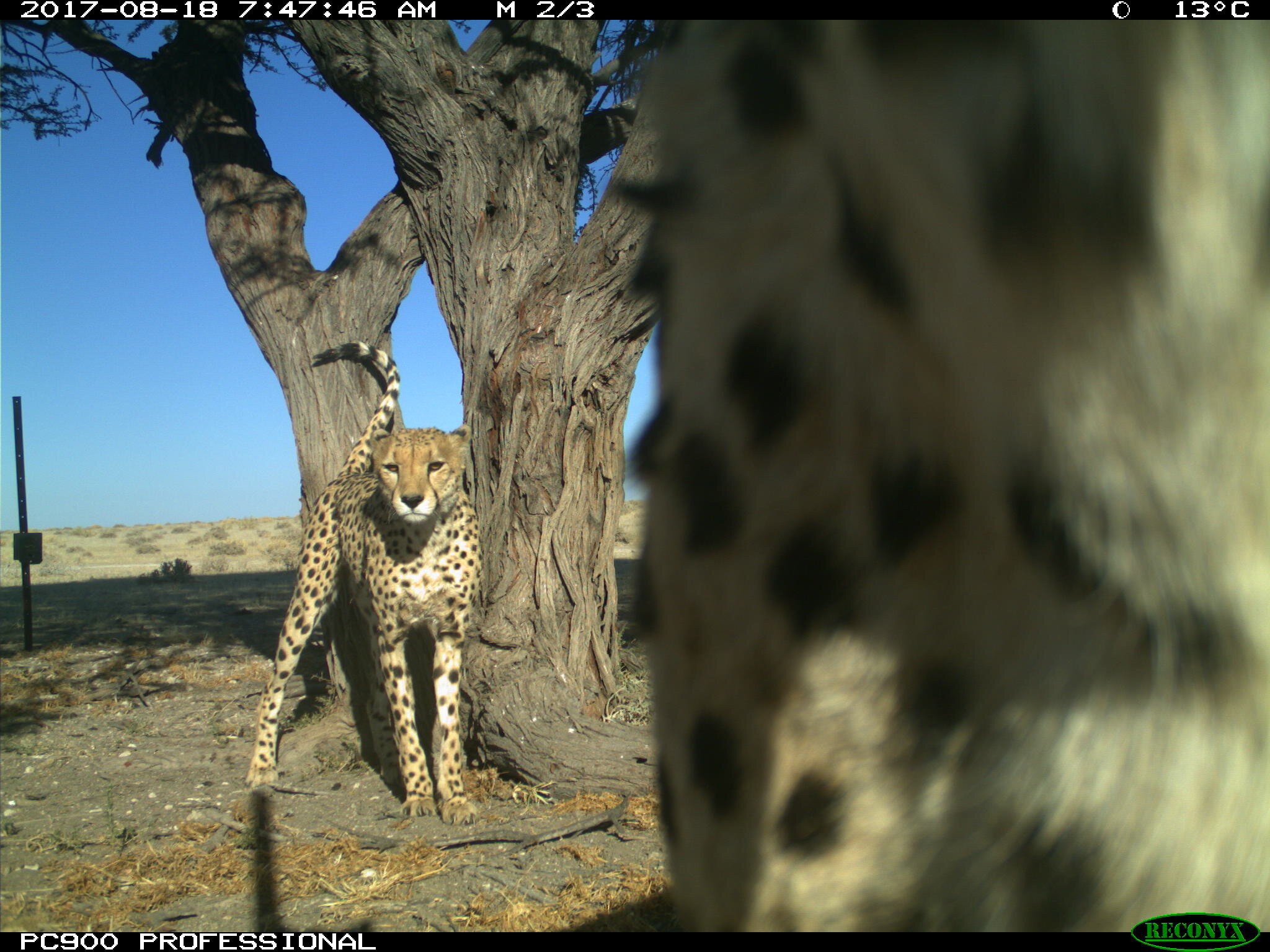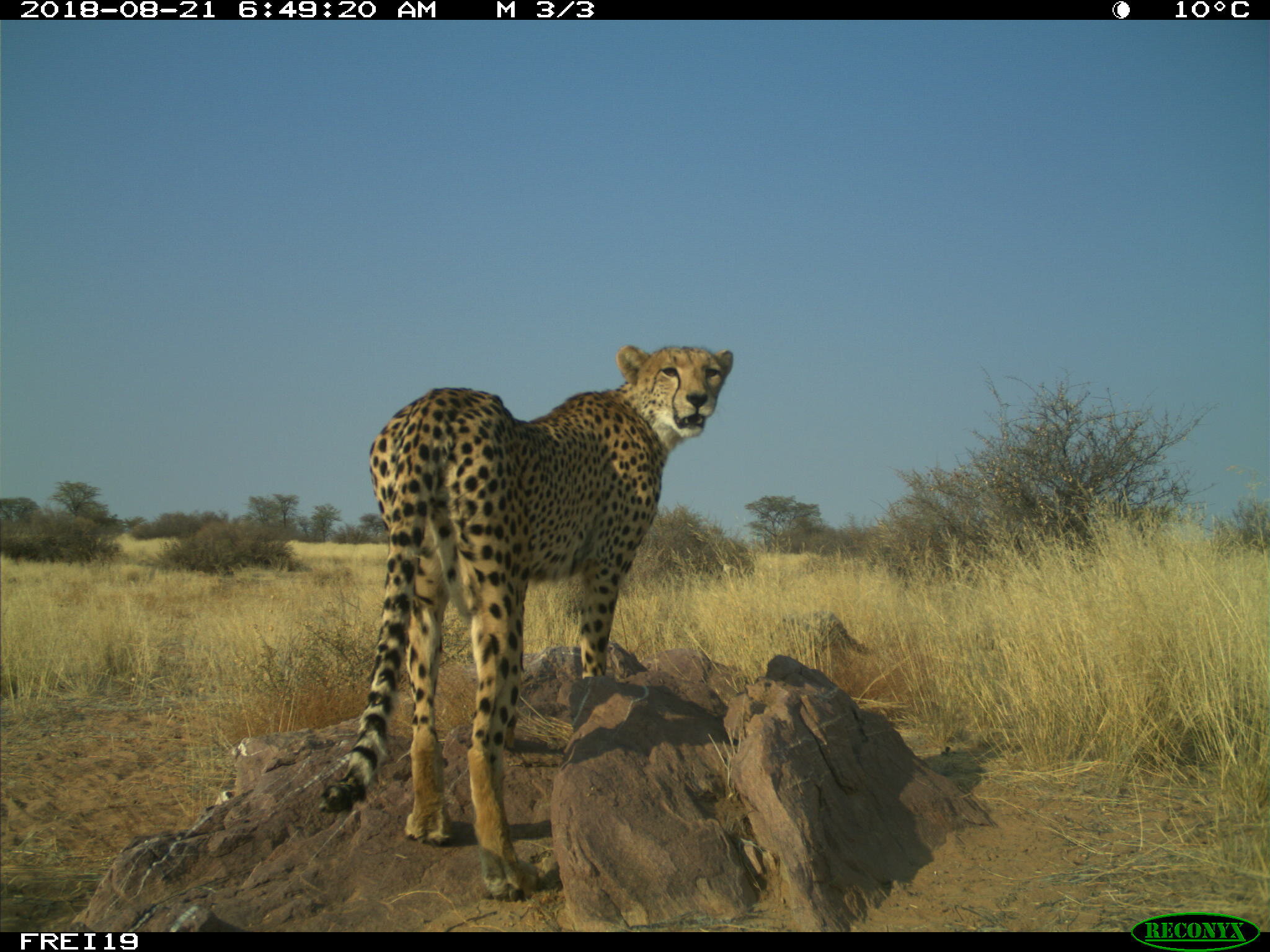Monitoring the population of cheetah is crucial to detect changes in numbers in different study areas and accordingly establish conservation strategies. In collaboration with the Ministry of Environment, Forestry and Tourism (MEFT) in Namibia, we are running a country-wide camera trap survey (“Namibian Cheetah Survey", see also our “Study areas”) to estimate the density of cheetah and establish a long-term monitoring study of the cheetah population to obtain population trends.
Using our long-term data and acquired biological knowledge of cheetah, we have developed a methodology adapted to the characteristic cheetah spatial ecology (for details see our sub-project “Spatial ecology and distribution of free-ranging cheetahs”). Our methods consist in identifying in the landscape marking sites that cheetahs use for intra-specific communication. These locations are typically in the core area of territorial males and visited regularly by the territorial males which mark the locations. Non-territorial males (floaters) and females also visit these trees to sniff, but only rarely mark. Within a cheetah territory, ten marking sites are selected to be surveyed with two camera traps each. A minimum of three territories are surveyed simultaneously as a block. This approach provides a high recapture rate, thus high accuracy in the density estimates which is uncommon for elusive and wide ranging large carnivores.
We focus on two complementary camera trap projects:
Since 2010, we use camera traps and a capture-recapture approach to estimate the cheetah density in our long-term study area in central Namibia. Camera trap surveys are regularly run every two years to provide population trends. A close collaboration with farmers allows us to also collect information on farm and predator management as well as on game counts. This is key to understand human-induced mortality of cheetahs and assess potential prey abundance for cheetahs. This information is crucial for a sound estimate on the cheetah status in the highlands of central Namibia, the stronghold of the species in Namibia and one of the key areas for its entire range.
Since 2015, we are running country-wide camera trap surveys to estimate the density of cheetah in study sites across Namibia (“Namibia Cheetah Survey”). These study sites are located in different biomes, land-uses, human pressures, vegetation communities throughout a rainfall gradient and varying prey densities. These surveys across Namibia aim to provide a good estimate on the cheetah population size and how it is affected by different factors. The final aim is providing a total population estimate to the governmental authorities for management purposes and ensuring the long-term survival of the species in Namibia.
Density estimation of other carnivore species:
We also carried out camera trap surveys to estimate the density and evaluate the status of other carnivore species such as leopard Panthera pardus and serval Leptailurus serval within Namibia.
Leopards are widely distributed in Namibia, yet little data is available for the northern part of the country. In collaboration with the MEFT, we carried out camera trap surveys to estimate leopard density in Khaudum National Park and in the Low Hoanib River in the Skeleton Coast, located in the north east and in the north west of Namibia, respectively. These are the first leopard density estimates based on camera trap surveys provided for these areas and critical data to evaluate species conservation status, establish science-based management plans and conservation strategies which ensure long-term conservation of leopards in Namibia.
In a different study carried out in the south of Namibia, we demonstrated that camera trap survey designed for other species than leopards can be used for occupancy and detection probability estimated for leopards. Our approach demonstrates how to make most of by-catch data in camera trap studies and that such studies can produce information far beyond that originally planned for.
Within Namibia, knowledge of serval is restricted to a handful of opportunistic camera trap records, with no focused surveys having been conducted. Together with other scientists we conducted the first density estimates for serval in Namibia in the Khaudum National Park (KNP) and the Mudumu-North Complex (MNC), two sites in the north-east of the country. These spatial density estimates are the second for southern Africa. As such, they represent information essential for the conservation of this under-studied felid. In addition, the serval records from KNP and the MNC, along with two other records from north-central Namibia were used to update the Namibian serval distribution map.
Publications reporting on these topics
Edwards A, Cooper S, Uiseb K, Hayward M, Wachter B, Melzheimer J 2018: Making the most of by-catch data: Assessing the feasibility of utilising non-target camera trap data for occupancy modelling of a large felid. African Journal of Ecology 56: 831-840. Doi: 10.1111/aje.12511.Edwards S, Fischer M, Wachter B, Melzheimer J 2018: Coping with intrasexual behavioural differences: Capture-recapture abundance estimation of male cheetah. Ecology and Evolution 8:9171-9180. Doi: 10.1002/ece3.4410. Portas R, Wachter B, Melzheimer J 2018: Namibian Cheetah Survey 2015-2017. Final report. Ministry of Environment and Tourism of the Republic of Namibia. Windhoek. 72 pages.Edwards, S., Portas, R., Hanssen, L., Beytell, P., Melzheimer, J. and Stratford, K. 2018. The spotted ghost: Density and distribution of serval Leptailurus serval in Namibia. African Journal of Ecology. 2018;1–10Portas, R., Wachter, B., Beytell, P., Uiseb, K.H., Melzheimer, J. and Edwards, S. Leopard Panthera pardus camera trap surveys in the Skeleton Coast and Khaudum National Park in northern Namibia. Submitted to Mammalian Biology






